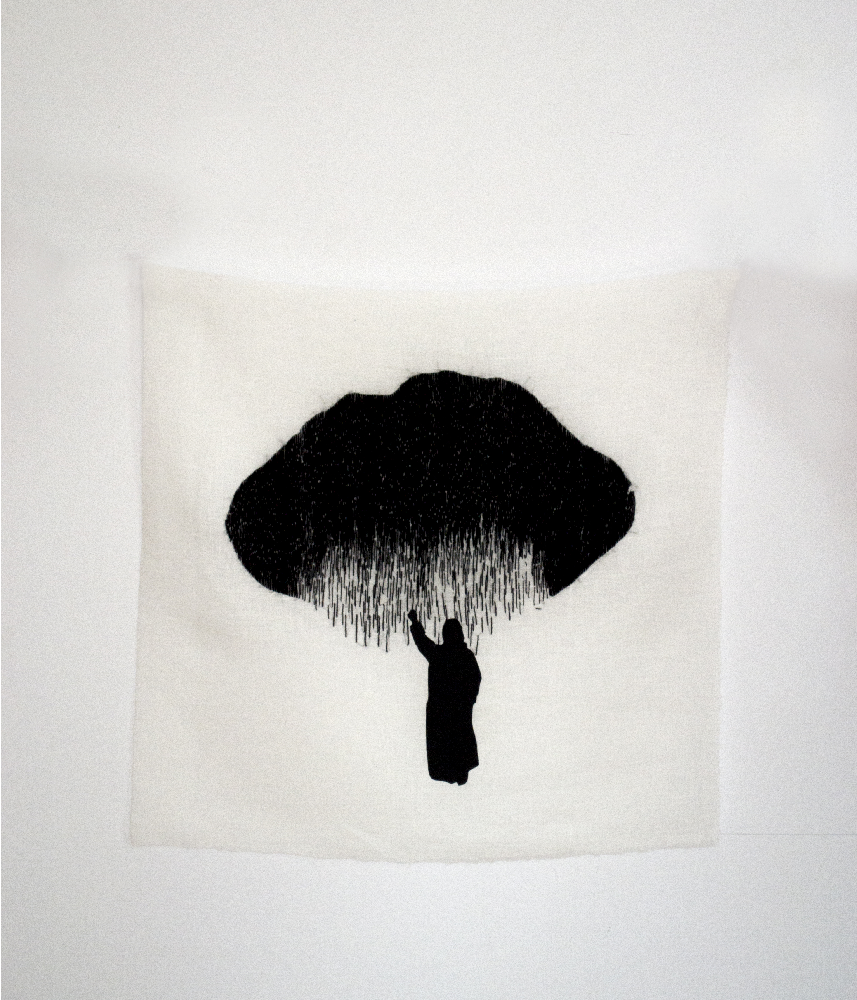Iulia Toma
Unexpected Dream/Dreams and Expectations
For a long time, associated with femininity and domesticity, obedience and passivity, the practice of embroidery is yet to receive the recognition it deserves within the realm of visual art. Engaging with a practice that has been marginalized along with those who employed it, namely women, Iulia Toma uses embroidery as a medium for drawing on fabric. Her sewing-machines stitch portraits depict women, men or children who have recently been forced to flee their homeland due to civil war, political unrest, and economic struggles.
The series of textiles as well a new video work the artist produced for the Art Encounters Biennial 2019 is a continuation of #orientalswelcome, a long-term project by the artist on the increasingly fearful and hostile attitudes towards immigration. Toma’s works are an expression of solidarity as well as increased consciousness towards those who have been displaced, situating embroidery at the intersection between art and activism, personal and political. The Romanian National Council for Refugees in Bucharest assisted the artist in contacting several refugees, the majority from Syria, Afghanistan, and Iran who accepted to share stories about their background and their current situation in Romania. However, in the fabric works, the artist isolates and obscures such narratives by placing the biographical content in a global context. The type of fabric, motifs, and colors are inspired by Persian art with tones of light and dark blue. Stitched on the fabrics, singular, stylized motifs in Persian rugs such as palm leaves and birds are recontextualized on the fabrics, and placed in relation to the subjects. Such a process highlights the relationship of subjects to a home far away, the experience of longing and the continuous acts of remembrance. AR
Iulia Toma (b. 1974, lives in Bucharest) uses textile fabrics, accompanied by photography, installation and text, as her preferred media. Social themes such as feminism, human rights, interpersonal relationships in closed communities, urban materiality of inhabitation, and social equity are the object of her pursuits. She teaches in the Arts & Textile Design Department of the National Arts University of Bucharest. Selected exhibitions: The web of Fabric, Ivan Gallery, Bucharest (2019); Objects in the Mirror Are Closer Than They Appear, Eastwards Prospectus Gallery, Bucharest (2018); Mapping Bucharest: Art, Memory and Revolution 1916–2016, Vienna Biennale, MAK Contemporary Art Collection (2015); Buongiorno Varvara Stepanova!, Galleriapíu, Bologna (2016, solo, alongside Claudiu Cobilanschi); Dura Europos, Ivan Gallery, Bucharest (2016); Twilled conections, Tranzit.ro (2015); Appearance and essence, 1st Art Encounters Biennale, Timișoara (2015).

Iulia Toma, Silkhouettes series, 2017, textile, embroidery, collage, courtesy of the artist, photo credit: Filip Drabek
Dan Acostioaiei
Halil Altındere
Forensic Architecture
Anca Benera & Arnold Estefan
Michael Beutler
Pauline Boudry & Renate Lorenz
Irina Botea Bucan & Jon Dean
Filipa César & Louis Henderson
Kray Chen
Collection Collective
Céline Condorelli
Alexandra Croitoru
Decolonizing Architecture Art Residency
Chto Delat
Aslan Gaisumov
Dora García
Ane Graff
Alma Heikkilä
Ane Hjort Guttu
Gülsün Karamustafa
Behzad Khosravi Noori
Gunilla Klingberg
Vilmos Koter
Zac Langdon-Pole
Matts Leiderstam
Anne Low
Virginia Lupu
Taus Makhacheva
Liliana Mercioiu Popa
Metahaven
Ana Maria Millán
Malgorzata Mirga-Tas
Naeem Mohaiemen
Monotremu
Tanja Muravskaja
Ciprian Mureșan
Joar Nango
Thao Nguyen Phan
Ho Tzu Nyen
Pınar Öğrenci
Ahmet Ögüt
The Otolith Group
Trevor Paglen
Philippe Parreno
Gary-Ross Pastrana
Peles Empire
Lia Perjovschi
Agnieszka Polska
Ghenadie Popescu
Walid Raad
Vandy Rattana
Bella Rune
STEALTH.unlimited
Zhou Tao
Iulia Toma
Tur de Arhitectură
Mona Vătămanu & Florin Tudor
Anton Vidokle
Haegue Yang
Mădălina Zaharia
Zephyr
Želimir Žilnik
